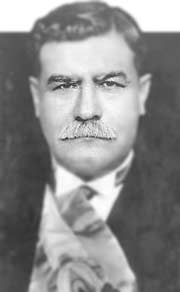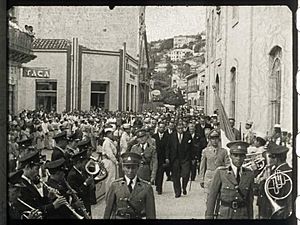Tiburcio Carías Andino facts for kids
Quick facts for kids
Tiburcio Carías Andino
|
|
|---|---|
 |
|
| 38th President of Honduras | |
| In office 1 February 1933 – 1 January 1949 |
|
| Vice President | Abraham Williams Calderón |
| Preceded by | Vicente Mejía Colindres |
| Succeeded by | Juan Manuel Gálvez |
| President of Honduras (Constitutional) |
|
| In office 27 April 1924 – 30 April 1924 |
|
| Preceded by | Francisco Bueso |
| Succeeded by | Vicente Tosta |
| Personal details | |
| Born | 5 March 1876 Tegucigalpa, Honduras |
| Died | 23 December 1969 (aged 93) Tegucigalpa, Honduras |
| Political party | PNH |
Tiburcio Carías Andino (born March 5, 1876 – died December 23, 1969) was an important Honduran politician and military leader. He became a major general in the army. Carías served as the 38th president of Honduras. His first time as president was for a short period in 1924. Later, he was elected president in 1933 during a difficult time for the world economy. He then ruled Honduras for a long time, until 1949. During his time, he made the country's army stronger, supported banana companies, and made sure Honduras paid its debts.
Contents
Early Life and Career
Growing Up in Honduras
Tiburcio Carías Andino was born in Tegucigalpa, Honduras, on March 15, 1876. His parents were Calixto Carías Galindo and Sara Francisca Andino Rivera. When he was young, he worked as a director at a boys' school. He also taught math at the "El Porvenir" institute. After high school, he studied criminal law at the Central University of Honduras.
Helping the Community
In 1905, Carías helped start the Hospital de Occidente project. Many people volunteered their time and money to build this hospital. It was a big community effort. The hospital was built thanks to donations from both the public and private groups. Later, in 1940, the government took over its healthcare services.
Becoming a Military Leader
Carías became well-known as a military leader. In 1907, he fought in the "Battle of Lizapa" and was promoted to General. He also helped found the Society of Craftsmen "El Porvenir" in 1908, which later became the Copaneca Workers' Society.
He played a big role in the Honduran civil wars of 1919 and 1924. During these wars, he was promoted to the rank of general. After the Second Civil War in 1924, he briefly held the presidency. He gained a lot of experience on the battlefield, which helped him become a powerful figure in Honduran politics.
Becoming President of Honduras
First Attempts at Presidency
After the civil wars, Carías ran for president several times. In the 1923 elections, he was a candidate for the National Party of Honduras. He won the most votes, but not enough to win outright. This led to some problems. In 1928, he ran again but lost to Vicente Mejía Colindres from the Liberal Party. Carías accepted the results, which was rare for the time. It showed a peaceful change of power between the two main parties. He also served as the President of the National Congress of Honduras from 1926 to 1929, and again from 1930 to 1931.
Winning the Presidency in 1933
On February 1, 1933, Tiburcio Carías Andino became President of Honduras for a long time – 16 years! The 1932 elections were fair, even though the Great Depression was causing problems worldwide. The outgoing president, Vicente Mejía, did not let his party cheat in the elections. So, Carías won by about 20,000 votes. He took office on November 16, 1932. This began the longest period a single person ruled Honduras.
Before he even officially became president, some people from the Liberal Party tried to start a revolt. Carías quickly took charge of the government forces, got weapons from El Salvador, and stopped the uprising. For most of his first term, he focused on preventing the country from going bankrupt, making the military better, building some roads, and planning how to stay in power longer.
Carías's Time in Power: The 1930s
Facing Economic Challenges
The economy was very bad in the 1930s because of the Great Depression. Banana exports dropped a lot. Also, diseases like Panama disease and Black sigatoka attacked banana plants in 1935. This threatened most of the country's banana production. Many areas were abandoned, and thousands of Hondurans lost their jobs. By 1937, a way to control the disease was found, but Honduras had lost some of its banana market to other countries.
Strengthening the Military
Carías worked hard to improve the military even before he became president. Once in office, he focused on it even more. He paid special attention to the new air force. In 1934, he started the Military Aviation School and brought in a United States colonel to lead it.
Managing the Economy
As time went on, Carías slowly but surely made his power stronger. He got the support of the banana companies by stopping strikes and other worker protests. He also gained trust from people who dealt with money, both in Honduras and other countries. He did this by being careful with the economy. Even during the worst of the depression, he kept making regular payments on Honduras's debts. He paid off two small loans completely in 1935.
Increasing Political Power
In 1935, Carías slowly started to control politics more. He made the Communist Party of Honduras illegal. However, the Liberal Party could still operate. Even leaders of a small uprising in 1935 were later offered free flights back to Honduras if they wanted to return from their exile.
By the end of 1935, Carías began to crack down on newspapers and political activities that opposed him. He said it was to keep peace and order. Meanwhile, his National Party started saying that only Carías staying in power could keep the country peaceful. But the constitution said a president could not be re-elected right away.
To stay in office, Carías called a special meeting to write a new constitution. This new constitution would allow him to be re-elected. The new 1936 constitution made some big changes. It removed the rule against immediate re-election for the president and vice president. It also made the presidential term longer, from four to six years. Other changes included bringing back the death penalty and reducing the power of the legislature (the law-making body). Women were also denied the right to vote. The new constitution also said that Carías would stay in office until 1943. But Carías, who was almost a dictator by then, wanted more time. So, in 1939, the legislature, which was now fully controlled by his party, extended his term for another six years, until 1949.
People who opposed Carías tried to overthrow him in 1936 and 1937. But all these attempts failed and only made the opposition weaker. By the end of the 1930s, the National Party was the only strong political party in Honduras. Many opposition leaders were put in prison, and some had to leave the country.
Relations with Other Leaders
During his presidency, Carías became good friends with other dictators in Central America. These included generals Jorge Ubico in Guatemala, Maximiliano Hernández in El Salvador, and Anastasio Somoza in Nicaragua. He was especially close with Ubico, who even helped Carías with his secret police.
The Cariato Regime
Carías's rule, known as the Cariato, was a very nationalistic and military-focused time. He admired Fascist Italy and Nazi Germany. He even sent letters to leaders like Adolf Hitler and Emperor Hirohito of Japan. Like fascist movements in Europe, Carías tried to create a strong national identity for Hondurans. He celebrated the Honduran mestizo identity as a link to the ancient Maya civilization. Because of this, his government started important excavations at Maya cities like Copan and El Puente.
Carías's Time in Power: The 1940s
Honduras and World War II
Even though Carías had friendly ties with Nazi Germany, Fascist Italy, and the Empire of Japan, he had to declare war on the Axis powers after the attack on Pearl Harbor in 1941. This meant Honduras became an ally of the United States. Honduras contributed soldiers and marines. The Honduran Air Force also patrolled the Caribbean Sea looking for German submarines. Carías even expelled the German consul from Honduras, believing he was a spy.
End of His Long Rule
In 1944, popular revolts in Guatemala and El Salvador removed their dictators. This made people wonder if the same would happen in Honduras. In May 1944, women protested outside the Presidential Palace in Tegucigalpa, asking for political prisoners to be freed. Carías was forced to release some prisoners. But protests continued, and in July, some demonstrators were killed by troops. Despite these problems, the military stayed loyal to Carías, and he remained in power.
The United States then began to pressure Carías to step down and allow fair elections when his term ended. Carías, who was in his early seventies, finally agreed. He announced elections for October 1948 and said he would not run. However, he still used his power to influence things. His National Party nominated Juan Manuel Gálvez, who had been his minister of war since 1933. Opposition figures were allowed to return to Honduras, and the Liberal Party nominated Ángel Zúñiga, the same person Carías had beaten in 1932. But the Liberals soon felt they couldn't win and accused the government of cheating. They decided not to participate in the elections. This meant Gálvez won easily, and he became president in January 1949.
After the Presidency
In 1954, Carías tried to become president again. But his decision to run caused a split in his own National Party. The Liberal candidate won the most votes but not a majority, which led to a problem. The vice president, Julio Lozano Díaz, then took power in a coup. This ended three decades of stable government in Honduras, during which Carías had been president for 16 years.
Legacy
It's tricky to judge Carías's time as president. He brought a much-needed period of peace and order to Honduras. The country's money situation got better, education improved a little, and the road network grew. The armed forces also became more modern. However, at the same time, democratic ideas weakened. Opposition groups and worker activities were stopped. Sometimes, the country's interests were put aside to benefit Carías's supporters or big foreign companies.
See also
 In Spanish: Tiburcio Carías Andino para niños
In Spanish: Tiburcio Carías Andino para niños


